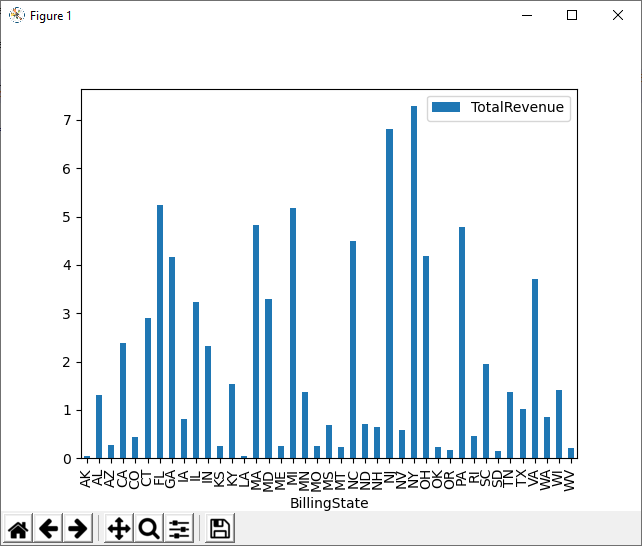Model Context Protocol (MCP) finally gives AI models a way to access the business data needed to make them really useful at work. CData MCP Servers have the depth and performance to make sure AI has access to all of the answers.
Try them now for free →How to Visualize NetSuite Data in Python with pandas
Use pandas and other modules to analyze and visualize live NetSuite data in Python.
The rich ecosystem of Python modules lets you get to work quickly and integrate your systems more effectively. With the CData Python Connector for NetSuite, the pandas & Matplotlib modules, and the SQLAlchemy toolkit, you can build NetSuite-connected Python applications and scripts for visualizing NetSuite data. This article shows how to use the pandas, SQLAlchemy, and Matplotlib built-in functions to connect to NetSuite data, execute queries, and visualize the results.
With built-in optimized data processing, the CData Python Connector offers unmatched performance for interacting with live NetSuite data in Python. When you issue complex SQL queries from NetSuite, the driver pushes supported SQL operations, like filters and aggregations, directly to NetSuite and utilizes the embedded SQL engine to process unsupported operations client-side (often SQL functions and JOIN operations).
About NetSuite Data Integration
CData provides the easiest way to access and integrate live data from Oracle NetSuite. Customers use CData connectivity to:
- Access all editions of NetSuite, including Standard, CRM, and OneWorld.
- Connect with all versions of the SuiteTalk API (SOAP-based) and SuiteQL, which functions like SQL, enabling easier data querying and manipulation.
- Access predefined and custom reports through support for Saved Searches.
- Securely authenticate with Token-based and OAuth 2.0, ensuring compatibility and security for all use cases.
- Use SQL stored procedures to perform functional actions like uploading or downloading files, attaching or detaching records or relationships, retrieving roles, getting extra table or column info, getting job results, and more.
Customers use CData solutions to access live NetSuite data from their preferred analytics tools, Power BI and Excel. They also use CData's solutions to integrate their NetSuite data into comprehensive databases and data warehouse using CData Sync directly or leveraging CData's compatibility with other applications like Azure Data Factory. CData also helps Oracle NetSuite customers easily write apps that can pull data from and push data to NetSuite, allowing organizations to integrate data from other sources with NetSuite.
For more information about our Oracle NetSuite solutions, read our blog: Drivers in Focus Part 2: Replicating and Consolidating ... NetSuite Accounting Data.
Getting Started
Connecting to NetSuite Data
Connecting to NetSuite data looks just like connecting to any relational data source. Create a connection string using the required connection properties. For this article, you will pass the connection string as a parameter to the create_engine function.
The User and Password properties, under the Authentication section, must be set to valid NetSuite user credentials. In addition, the AccountId must be set to the ID of a company account that can be used by the specified User. The RoleId can be optionally specified to log in the user with limited permissions.
See the "Getting Started" chapter of the help documentation for more information on connecting to NetSuite.
Follow the procedure below to install the required modules and start accessing NetSuite through Python objects.
Install Required Modules
Use the pip utility to install the pandas & Matplotlib modules and the SQLAlchemy toolkit:
pip install pandas pip install matplotlib pip install sqlalchemy
Be sure to import the module with the following:
import pandas import matplotlib.pyplot as plt from sqlalchemy import create_engine
Visualize NetSuite Data in Python
You can now connect with a connection string. Use the create_engine function to create an Engine for working with NetSuite data.
engine = create_engine("netsuite:///?Account Id=XABC123456&Password=password&User=user&Role Id=3&Version=2013_1")
Execute SQL to NetSuite
Use the read_sql function from pandas to execute any SQL statement and store the resultset in a DataFrame.
df = pandas.read_sql("SELECT CustomerName, SalesOrderTotal FROM SalesOrder WHERE Class_Name = 'Furniture : Office'", engine)
Visualize NetSuite Data
With the query results stored in a DataFrame, use the plot function to build a chart to display the NetSuite data. The show method displays the chart in a new window.
df.plot(kind="bar", x="CustomerName", y="SalesOrderTotal") plt.show()

Free Trial & More Information
Download a free, 30-day trial of the CData Python Connector for NetSuite to start building Python apps and scripts with connectivity to NetSuite data. Reach out to our Support Team if you have any questions.
Full Source Code
import pandas
import matplotlib.pyplot as plt
from sqlalchemy import create_engin
engine = create_engine("netsuite:///?Account Id=XABC123456&Password=password&User=user&Role Id=3&Version=2013_1")
df = pandas.read_sql("SELECT CustomerName, SalesOrderTotal FROM SalesOrder WHERE Class_Name = 'Furniture : Office'", engine)
df.plot(kind="bar", x="CustomerName", y="SalesOrderTotal")
plt.show()

